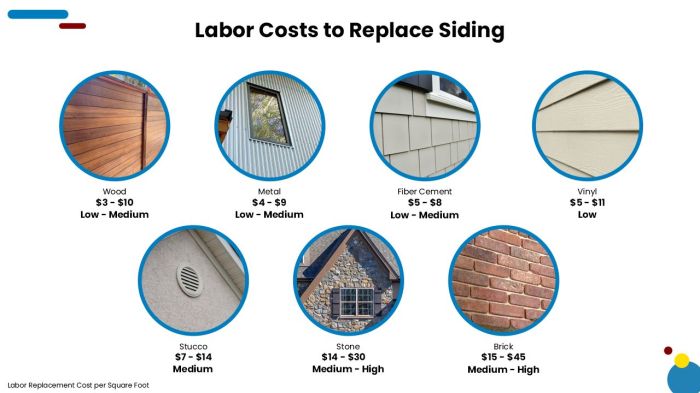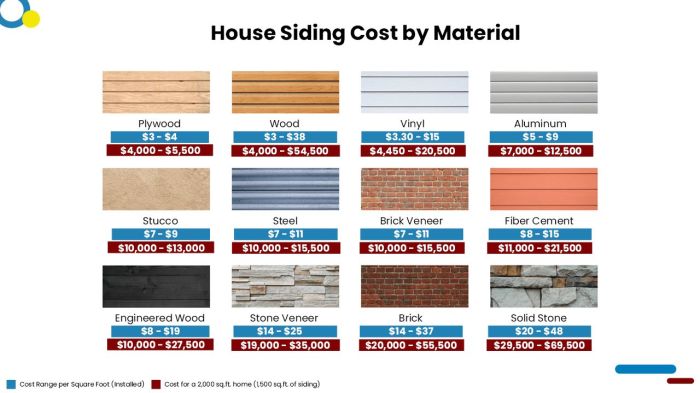Cost to Install New Siding on House: A Comprehensive Guide to Understanding Expenses
Exploring the cost to install new siding on a house opens up a world of possibilities and considerations. From the materials used to the size of the project, each factor plays a crucial role in determining the overall expenses. Let's delve into the intricacies of this topic and unravel the mysteries surrounding siding installation costs.
As we navigate through the details, you'll gain valuable insights that will help you make informed decisions when it comes to revamping your home's exterior.
Factors influencing the cost of new siding installation

When considering the cost of installing new siding on your house, several factors come into play that can impact the overall price. Understanding these factors can help you make informed decisions about your siding project.
Types of siding materials and their cost range
Different types of siding materials come with varying costs, which can significantly affect the total installation price. Here are some common siding materials and their approximate cost ranges per square foot:
- Vinyl siding: $3 - $8
- Fiber cement siding: $5 - $12
- Wood siding: $6 - $15
- Brick siding: $8 - $15
Size of the house affecting the total cost
The size of your house plays a crucial role in determining the total cost of siding installation. Larger houses will require more materials and labor, leading to higher costs compared to smaller homes.
Complexity of the installation job impacting pricing
The complexity of the installation job can also influence the overall pricing. Factors like the shape of the house, the presence of architectural details, and the need for additional preparation work can increase the labor and time required, thus raising the total cost of installation.
Additional expenses that may be involved
Beyond the basic materials and labor costs, there are additional expenses that homeowners should consider when budgeting for new siding installation. These may include:
- Permit fees
- Removal and disposal of old siding
- Repairs to the underlying structure
- Trim work and accessories
Cost breakdown of installing new siding

Installing new siding involves costs for both materials and labor. Here is a breakdown of the costs and factors that influence them:
Materials and Labor Costs Breakdown
When it comes to new siding installation, the costs can vary depending on the type of siding material used. Here is a general breakdown of costs for materials and labor:
| Siding Material | Average Cost per Square Foot |
|---|---|
| Vinyl | $3
|
| Fiber Cement | $5
|
| Wood | $6
|
Different siding materials have varying costs per square foot, with wood typically being more expensive than vinyl or fiber cement.
Labor Rates Impact
The cost of labor for new siding installation can also vary depending on factors such as location, complexity of the job, and the experience of the contractor. Different labor rates can significantly impact the overall installation cost, so it's essential to consider this when budgeting for your project.
Ways to estimate the cost before starting the project
Before diving into a siding installation project, it's crucial to have a clear idea of the costs involved. Here are some steps to help you estimate the expenses upfront.
Step-by-step guide on how to measure the square footage of the house
To calculate the square footage of your house for siding installation, follow these steps:
- Start by measuring the width and height of each rectangular section of your house.
- Break down complex areas into smaller rectangles for easier calculations.
- Multiply the width by the height of each section to get the square footage of that area.
- Add up the square footage of all sections to get the total square footage of your house.
Discuss how to get accurate quotes from contractors
When requesting quotes from contractors for siding installation, consider the following tips:
- Provide detailed information about your project, including the type of siding you prefer and any specific requirements.
- Request quotes from multiple contractors to compare prices and services offered.
- Ask for a breakdown of the costs, including materials, labor, and any additional charges.
- Ensure that the quotes are in writing to avoid any misunderstandings later on.
Share tips on negotiating prices for materials and labor
Negotiating prices for materials and labor can help you save on costs during the siding installation project. Here are some negotiation tips:
- Research the average costs of materials and labor in your area to have a baseline for negotiation.
- Consider purchasing materials in bulk to potentially get a discount from suppliers.
- Ask contractors if they offer any discounts for paying in cash or scheduling the project during a slower season.
- Be willing to negotiate and communicate openly with contractors to reach a mutually beneficial agreement.
Comparing DIY vs. professional siding installation costs
When it comes to installing new siding on your house, you may be considering whether to tackle the project yourself or hire professional contractors. Each option comes with its own set of advantages and disadvantages, as well as varying costs.
Let's take a closer look at the differences between DIY and professional siding installation costs.
Advantages and disadvantages of DIY siding installation
- Advantages:
- Cost savings on labor fees
- Flexibility in scheduling and completion timeline
- Personal satisfaction and pride in completing the project
- Disadvantages:
- Requires time, effort, and skill to complete the job correctly
- Potential for mistakes that may lead to additional costs for repairs
- Lack of warranty or guarantee on the work
Potential cost savings with DIY projects
DIY siding installation can save you money on labor costs, which can often make up a significant portion of the total project expenses. By taking on the project yourself, you have the opportunity to reduce overall costs and allocate your budget towards higher-quality materials or other home improvement projects.
Why hiring professionals may be a better investment in some cases
- Professional expertise: Experienced contractors have the knowledge and skills to ensure proper installation, minimizing the risk of errors or future issues.
- Time and efficiency: Professionals can complete the project more quickly and efficiently, saving you time and hassle in the long run.
- Quality guarantee: Hiring professionals often comes with warranties or guarantees on their work, providing you with peace of mind and protection in case of any issues.
End of Discussion
In conclusion, understanding the cost to install new siding on a house is not just about the numbers, but about the transformation it brings to your property. By being aware of the various factors and options available, you are better equipped to embark on this exciting journey of home improvement.
Commonly Asked Questions
What factors can influence the cost of new siding installation?
Factors such as the type of siding materials, the size of the house, the complexity of the installation job, and additional expenses can all impact the overall cost.
How can I estimate the cost before starting the project?
You can estimate the cost by measuring the square footage of your house, getting accurate quotes from contractors, and negotiating prices for materials and labor.
What are the advantages of DIY siding installation?
DIY projects can offer potential cost savings, but it's important to weigh the advantages against the disadvantages and the skill level required for successful installation.




